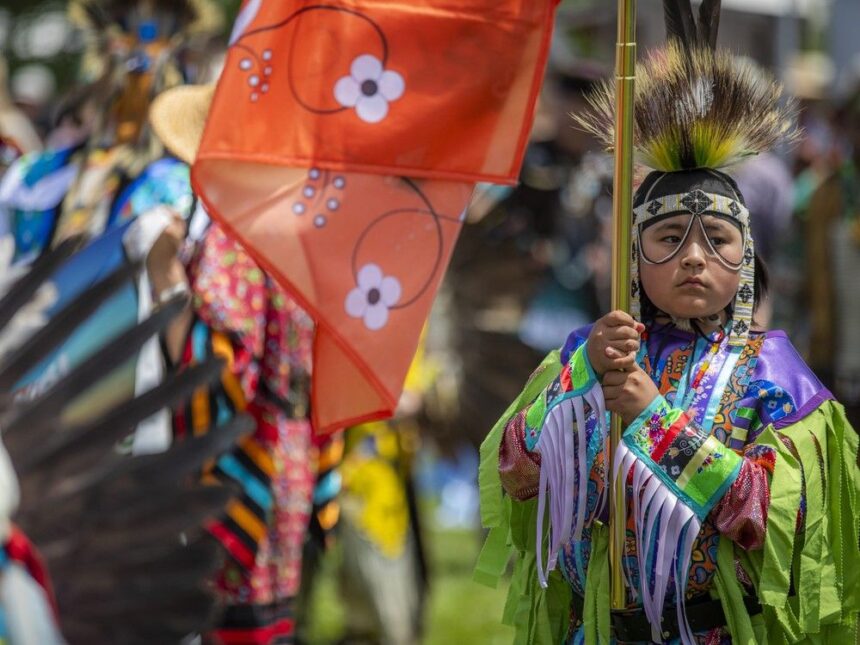The rhythmic beat of traditional drums echoed across Mādahòkì Farm this weekend as thousands gathered to celebrate the Ottawa Summer Solstice Indigenous Festival, marking both National Indigenous Peoples Day and the summer solstice with vibrant cultural displays that bridged ancient traditions with contemporary Indigenous excellence.
Under clear blue skies, attendees moved through a colorful tapestry of Indigenous experiences—from traditional dance competitions and culinary showcases to artisan markets featuring handcrafted works from Indigenous creators across the region. The three-day celebration, which concluded Sunday, has grown significantly since its inception, now standing as eastern Canada’s premier Indigenous cultural festival.
“This festival represents more than just a gathering—it’s a living demonstration of Indigenous resilience and cultural revitalization,” explained Trina Mather-Simard, Executive Director of Indigenous Experiences, the organization behind the annual event. “When visitors engage with our traditions, sample our foods, and witness our ceremonies, they gain a deeper understanding of Indigenous peoples as not just historical figures, but as vibrant, contemporary communities.”
The Summer Solstice Indigenous Festival has evolved dramatically over its 23-year history. What began as a modest one-day celebration at Vincent Massey Park has transformed into a major cultural event drawing Indigenous participants from First Nations, Métis and Inuit communities across Canada, alongside thousands of non-Indigenous visitors eager to learn and participate.
This year’s programming showcased the remarkable diversity within Indigenous cultures. The powwow competition drew dancers in regalia representing distinct cultural traditions, while the Indigenous Marketplace featured more than 40 artisans offering everything from traditional beadwork to contemporary art pieces. The Indigenous culinary pavilion proved particularly popular, with attendees forming long lines to sample traditional foods with modern twists.
“The dishes we prepare carry our stories,” said Chef Shawn Adler, who participated in the culinary showcase. “Indigenous food traditions are about sustainability, connection to the land, and community—values that resonate strongly today as we face environmental challenges and food security issues across Canada.”
Educational components remained central to the festival’s mission. Interactive workshops on traditional crafts, language preservation efforts, and environmental stewardship drew participants of all ages. A special area dedicated to truth and reconciliation provided resources for visitors seeking to understand the impacts of residential schools and the ongoing journey toward healing.
“Education happens naturally here,” noted Elder Annie Smith St-Georges, who conducted blessing ceremonies throughout the weekend. “When people participate in our ceremonies or listen to our stories, they begin to understand Indigenous world views in ways that textbooks simply cannot convey.”
The festival’s timing—coinciding with both the summer solstice and National Indigenous Peoples Day on June 21—holds deep significance. For many Indigenous communities, the summer solstice represents a time of renewal and celebration, marking the longest day of the year and the beginning of summer.
Festival organizers point to growing attendance numbers as evidence of increasing public interest in Indigenous cultures and reconciliation efforts. This year’s event drew approximately 40,000 visitors over three days—a record for the festival and a promising indicator of evolving attitudes.
“What we’re witnessing is a genuine desire among Canadians to understand Indigenous perspectives and build meaningful relationships,” Mather-Simard observed. “The festival creates a welcoming space for that understanding to develop naturally through shared experiences.”
Looking ahead, organizers plan to expand programming for next year’s festival while maintaining its core focus on authenticity and community-led initiatives. The success of this year’s event demonstrates how Indigenous cultural celebrations can serve as powerful platforms for both preserving traditions and fostering cross-cultural understanding.
As the final drum beats faded Sunday evening and families gathered their belongings, the festival’s impact lingered in conversations between new friends and in children proudly displaying their first attempts at traditional crafts. In a nation still navigating the complex path of reconciliation, these moments of cultural exchange and mutual respect provide glimpses of what meaningful progress might look like.
As we reflect on the vibrancy of the Summer Solstice Indigenous Festival, one question emerges: How might these brief moments of cultural immersion translate into lasting changes in how we understand and honor Indigenous perspectives in our daily lives?























